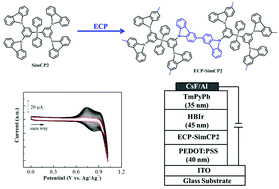Electrochemically deposited interlayer between PEDOT:PSS and phosphorescent emitting layer for multilayer solution-processed phosphorescent OLEDs†
Abstract
Corrosion and exciton quenching of commonly used interlayer PEDOT:PSS for OLEDs have been paid great attention, and an effective method is to insert a thin interlayer between PEDOT:PSS and an active layer. Herein, we report an electrochemical method (ECP) to deposit such an interlayer on PEDOT:PSS. Meanwhile, such an interlayer is designed as insoluble and conductive with electronic structures of a wide-bandgap and high triplet state level as well, which are particularly suitable for solution-processed multilayer phosphorescent OLEDs. Accordingly, the molecule SimCP2 was selected as the precursor for electrochemical deposition. The oxidation coupling reactions between the cabazoles in SimCP2 result in a deposition of cross-linked thin film on PEDOT:PSS layer. A solution-processed hyperbranched polymer (HBIr) with fac-tris(2-phenylpyridine)iridium (Ir(ppy)3) as the core and 3,6-carbazole-co-2,8-dioctyldibenzothiophene-S,S-dioxide-3,7-diyl as the branch was used as a phosphorescent active layer to verify the effect of the new interlayer. When the ECP interlayer with an optimal thickness was inserted, the luminance of PhOLEDs device increased from 5000 cd m−2 of the control device to 7368 cd m−2, leading to an enhancement of luminous efficiency (LE) and external quantum efficiency (EQE) from 24.4 cd A−1 and 9.0% of the control device to 32.5 cd A−1 and 12%, respectively. The cross-linked ECP interlayer not only effectively protects the triplet excitons from quenching at the interface between the emitting layer (EML) and PEDOT:PSS, but also blocks the superfluous holes injected and the electrons passed through the EML, which greatly improves device performances. This study paves the way for future applications of ECP interlayers towards highly efficient flexible organic optoelectronic devices.


 Please wait while we load your content...
Please wait while we load your content...